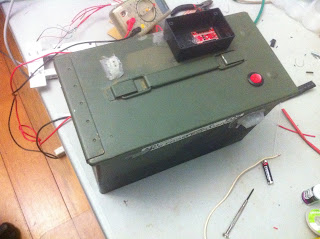I have been working hard over the last two days finishing off all the odds and ends remaining. The test stand is now mounted on the trailer and looking good. Electronics boxes are %90 completed. I have been having some trouble with the sensors, in particular with the strain gauge amplifier. A friend has been helping me quite a bit by making the circuit but it doesn't seem to work. At first it was drawing too much current. He got that fixed but now the output doesent change. The circuit is off Richard Nakka's website (http://www.nakka-rocketry.net/strainlc.html) The source of trouble seems to be that it needs a separate positive and negative power supply which are both connected to a common ground. Richard suggests using two 9V batteries. Rob is going to have another go tommoro but if he cant get it going I will have to try to look for an alternative. This will probably mean that the first test will not have thrust measuring capability as any parts i order will take a while to arrive and I would like to have everything going by the end of this week. I still havent tested the pressure transducer but it shouldn't be nearly as problematic as the load cell because it has a amplifier built in, the only issue i can think of is that it requires a 18V input (designed for trucks) and outputs 6V, which will need to be reduced to 5. Another strange thing about the load cells i bought off ebay is that that have a wheatstone bridge built into them, and just have a voltage in and a voltage out. This means you cant read the strain gauges directly and cant figure out what gain to use as in the opp amp easily. Hopefully i can start pressure testing the entire system tomorrow although thats a bit optimistic. I am a bit worried that the flow through the injectors will be too high (because of wrongly sized injectors), but i think (am not sure) that this should stabilise because more propellant means more pressure which will reduce the flow rate as the feed pressure is fixed. This can cause combustion instability, but thats really only a issue for rockets with large combustion chambers. Here are a few pictures of the carious components. I would like to do into some things in more detail but i figure its better to spend my time building. Also now that i look at it the pictures are not that great so i will try to get some good ones for the next post.







No comments:
Post a Comment